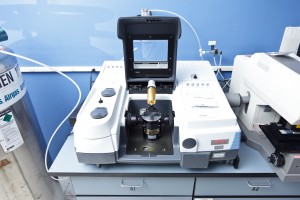
One of the most basic and useful “tools” of scientific discovery has been around literally since the dawn of time, and the human race started using it even before we had a name for it. What is this wonder tool? Light!
Illumination allows us to see what we’re doing and make basic observations about scientific analysis, and measuring different light wavelengths can tell us a lot about a material. In polymer testing, we use spectroscopy — the examination of how matter in a solid, liquid or gaseous form reacts with light — to determine data about a given material.
By shining a beam of light onto a sample and measuring how much light the material absorbs, reflects or allows to pass through it, we can tell a lot about the material’s molecular structure. This process — spectroscopy — can work for matter that reacts to both the visible spectrum of light, and materials that react with light waves outside what we can see with the naked eye (infrared light). Infrared spectroscopy helps us read infrared absorption and transmission, and create a molecular “fingerprint” of a material. Just like people, no two unique molecular structures produce exactly the same infrared fingerprint.
Fourier transform infrared spectroscopy (FTIR) is even more powerful, allowing us to collect and process large quantities of spectrometric data using a mathematical formula called the Fourier transform. FTIR analysis has many advantages over other spectrometry tests.
It doesn’t require us to destroy the sample, which can be especially helpful when we’re dealing with a very small sample quantity. It’s also very precise and fast, as well as sensitive and able to scan very tiny samples. For example, we could use FTIR analysis to successfully scan and quantify a sample one-tenth the size of the period at the end of this sentence. Finally, it allows us to scan multiple infrared light frequencies — or all of them — at one time, using a single test to deliver a wealth of data.
FTIR is a versatile and powerful analysis tool when conducting polymer testing. For example, it’s great for film testing, such as the transparent films used in food packaging, because it allows us to simultaneously identify each layer of the film. It’s also useful for competitive analysis. In that capacity, we’ve put it to work in some offbeat applications, too. We used FTIR to analyze a wireless bra because the padding needed to be identified, and we had 650 pellets covered in different-colored specs that weren’t supposed to be there. FTIR helped us understand what those contaminating specs really were and what they meant for the product’s usefulness.
FTIR analysis is just one example of how scientific testing often takes the most basic thing — light — and uses it in innovative ways to help us better understand the world around us.
